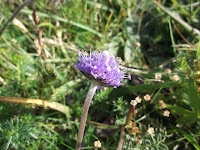Thanks to Alistair we found many different fungi on our INHT rAmble last Sunday at Loch Skerrols. The area itself is beautiful, with the loch looking picturesque in the calm conditions...
...and we headed into the woods to see what we could find.
The range of size, colours and smells of the fungi was amazing, and the more we looked the more we found, as is ever the case when looking at nature. Here's Alistair describing what he's seen to the group...
One of my favourites was Splitgill (Schizophyllum commune), the name describing how underneath the gills are split (that's what I love about mycology, there's always a clue in the name!) - I think they look like tiny white furry paws! AND it's a relatively new record for Islay so well done to Alistair for finding it.
 |
| Splitgill (Schizophyllum commune) |
Another interesting one for me was the Wood Hedgehog (Hydnum repandum) - the fungus rather than the mammal! Again the name comes from what it looks like underneath, which is this...
 |
| Wood Hedgehog (Hydnum repandum) |
As you can see it looks quite spiky, which you can see in this photo too...
 |
| Wood Hedgehog (Hydnum repandum) |
I find identifying fungi quite difficult due to their changing appearance throughout their life cycle, and it seems I'm not alone, as suggested by the name of the next one, the Deceiver (Laccaria laccata), so called because it changes so much it can be mistaken for other things.
 |
| Deceiver (Laccaria laccata) |
At least another one, the Amethyst Deceiver (Laccaria amethystina), is lilac coloured, making it a little easier to identify.
And then there was the Earthfan (Thelephora penicillata), a strange-looking fungus that forms rosette-like clusters among mosses on the forest floor. One feature of them is that however good a specimen it is, it always looks like it's been trodden on!
 |
| Earthfan (Thelephora penicillata) |
It often pays to look really closely at the forest floor too, and you may see something like this Stagshorn fungus (the yellow one)...
 |
| Calocera spp. |
...and this one which could be Hare's Ear (
Otidea onotica).
 |
| Hare's Ear (Otidea onotica) |
Here's a list of what we found on the day, with more photos to come no doubt! Many thanks Alistair for hisvexpertise, to Fiona for taking the photos and to everyone for their pleasant company on our fungi foray! Mandy
Fungi:
Tawny Grisette (Amanita
fulva)
Bay Bolete (Boletus
badius)
Stagshorn (Calocera spp.)
Shaggy Inkcap (Coprinus
comatus)
Webcap (Cortinarius spp)
Ganoderma (possibly Ganoderma
applanatum or Artist's Bracket)
Hoof Fungus / Tinder Bracket (Fomes fomentarius)
Common Rustgill (Gymnopilus
penetrans)
Poisonpie (Hebeloma spp)
Wood Hedgehog (Hydnum
repandum)
White Fibrecap (Inocybe
geophylla)
Laccaria spp
Amethyst Deceiver (Laccaria
amethystina)
Deceiver (Laccaria
laccata)
Mild Milkcap (Lactarius subdulcis)
Brown Birch Bolete (Leccinum
scabrum)
Bonnet (Mycena spp)
Hare's Ear (Otidea
onotica) or Tan Ear (Otidea alutacea)
Porcelain Fungus (Oudemansiella
mucida)
Deer Shield (Pluteus
cervinus)
Brittlestem (Psathyrella
spp.)
Pink Brittlegill (Russula)
Winecork Brittlegill (Russula
adusta) or Crowded Brittlegill (Russula
densifolia)
Yellow Swamp Brittlegill (Russula
claroflava)
Charcoal Burner (Russula
cyanoxantha)
Sickener (Russula
emetica)
Geranium Brittlegill (Russula
fellea)
Beechwood Sickener (Russula
nobilis)
Ochre Brittlegill (Russula
ochroleuca)
Splitgill (Schizophyllum
commune)
Urchin Earthfan (Thelephora
penicilliata)
Turkey tail (Trametes
versicolor)
Birch Knight (Tricholoma
fulvum)
Soapy Knight (Tricholoma
saponaceum)
Velvet Bolete (Suillus
variegatus)













 Along with a hand written greeting message, the typed information introduced The Drift Bottle Project. It explained that this project
was launched in summer 2014 to look at surface circulation in the North
Atlantic ocean, in the wider context of global ocean circulation. The project is
run by the Students on Ice (SOI) Arctic Expedition and Fisheries and Oceans Canada, with
involvement from international high school students, world-class scientists,
explorers and educators.
Along with a hand written greeting message, the typed information introduced The Drift Bottle Project. It explained that this project
was launched in summer 2014 to look at surface circulation in the North
Atlantic ocean, in the wider context of global ocean circulation. The project is
run by the Students on Ice (SOI) Arctic Expedition and Fisheries and Oceans Canada, with
involvement from international high school students, world-class scientists,
explorers and educators. 





